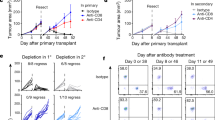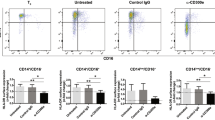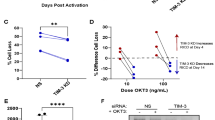Abstract
Soluble HLA class I molecules (sHLAs) have been identified in the serum of patients with inflammatory diseases, allografts and autoimmune diseases and in serum of healthy individuals. The biological significance of these molecules, particularly after allogeneic organ transplantation, has been enigmatic. Here we show that primary alloreactive CD8 T cells interact with sHLA and undergo apoptosis in the absence of a second signal. Ligation of CD28 rescued T cells from death, implying that sHLAs induce apoptosis through selective stimulation of the T–cell receptor. CD95–L was upregulated after cytotoxic T lymphocytes were incubated with sHLAs, and cell death was blocked by a neutralizing anti–CD95–L antibody, suggesting that sHLAs induce endogenous mutual killing of activated T cells. These results provide a molecular basis for the capacity of sHLAs to downregulate T–cell responses, which may be especially relevant to organ transplantation.
This is a preview of subscription content, access via your institution
Access options
Subscribe to this journal
Receive 12 print issues and online access
$209.00 per year
only $17.42 per issue
Buy this article
- Purchase on Springer Link
- Instant access to full article PDF
Prices may be subject to local taxes which are calculated during checkout
Similar content being viewed by others
References
Van Rood, J., Van Leeuwen, A. & Van Santen, M. Anti HL-A2 inhibitor in normal human serum. Nature 226, 366–367 (1970).
Zavazava, N., Bottcher, H. & Muller-Ruchholtz, W. Soluble MHC class I antigens (sHLAs) and anti-HLA antibodies in heart and kidney allograft recipients. Tissue Antigens 42, 20–26 (1993).
Puppo, F., Scudeletti, M., Indiveri, F. & Ferrone, S. Serum HLA class I antigens: Markers and modulators of an immune response? Immunol. Today 16, 124–127 (1995).
Charlton, R. & Zmijewski, C. Soluble HL-A7 antigen: Localization in the P-lipoprotein fraction of human serum. Science 170, 636–637 (1970).
Calne, R. et al. Induction of immunological tolerance by porcine liver allo-grafts. Nature 223, 472–476 (1969).
Sriwatanawongsa, V., Davies, H. & Calne, R. et al. The essential roles of parenchymal tissues and passenger leukocytes in the tolerance induced by liver grafting in rats. Nature Med. 1, 428–432 (1995).
Starzl, T. Demetris, A. & Van Thiel, D. Liver transplantation. N. Engl. J. Med. 10, 1092–1099 (1989).
Starzl, T. et al. Donor cell chimerism permitted by immunosuppressive drugs: A new view of organ transplantation. Immunol. Today. 326, 326–332 (1993).
Schlitt, H. et al.Pattern of donor-type microchimerism after heart transplantation. Lancet 343, 1469–1471 (1994).
Taniguchi, H., Toyoshima, T. & Nakuchi, H. Presence of hematopoi-etic stem cells in the adult liver. Nature Med. 2, 198–203 (1995).
Altman, J. et al. Human islet cotransplantation with liver or kidney. Transplant Proc. 224, 967–968 (1994).
Gonwa, T., Nery, J., Husberg, B. & Klintmalm, G. Simultaneous liver and renal transplantation in man. Transplantation 46, 690–693 (1988).
Calne, R. & Davies, H. Organ graft tolerance: The liver effect. Lancet. 343, 67–68 (1994).
Zavazava, N., Hausmann, R. & Mueller-Ruchholtz, W. . Inhibition of anti-HLA-B7 alloreactive CTLs by affinity purified soluble HLA. Transplantation, 51, 838–842 (1991).
Hausmann, R., Zavazava, N., Steinmann, J. & Mueller-Ruchholtz, W. Interaction of papain-digested HLA class I molecules with human alloreactive cytotoxic T lymphocytes (CTL). Clin. Exp. Immunol. 91, 183–188 (1993).
Clayberger, C. et al. HLA-A2 peptides can regulate cytolysis by human allo-geneic T lymphocytes. Nature 330, 763–765 (1987).
Parham, P. et al. Inhibition of alloreactive cytotoxic T lymphocytes by peptides from the oc2 domain of HLA-A2. Nature 325, 625–628 (1987).
Abastado, J., Lone, Y., Casrouge, A., Boulot, G. & Kourilsky, P. Dimerization of soluble major histocompatibility complex-peptide complexes is sufficient for activation of T cell hybridoma and induction of unresponsiveness. J. Exp. Med. 182, 439–447 (1995).
Kane, K., Sherman, L. & Mescher, M. Molecular interactions required for triggering alloantigen-specific cytolytic T lymphocytes. J. Immunol. 142, 4253–4160 (1989).
Kane, K., Vitiello, A., Sherman, L. & Mescher, M. Cytotoxic T-lymphocytes response to isolated class I H-2 proteins and influenza peptides. Nature. 340, 157–159 (1989).
Lenardo, M. Interleukin-2 programs mouse antibody T lymphocytes for apoptosis. Nature 353, 858–861 (1991).
Nagata, S. & Golstein, P. The Fas death factor. Scienc 267, 1449–1456 (1995).
Tanaka, M., Suda, T., Takahashi, T. & Nagata, S. Expression of the functional soluble form of human Fas ligand in activated lymphocytes. EMBO J 14, 1129–1135 (1995).
Ostergaard, H. & Clark, W. Evidence for multiple lytic pathways used by cytotoxic T lymphocytes. J. Immunol. 143, 2120–2126 (1989).
Ju, S., Ruddle, N., Strack, P. Dorf, M. & Dekruyff, R. Expression of two distinct cytolytic mechanisms among murine CD4 subsets. J. Immunol. 144, 23–31 (1990).
Duke, R. Purified perforin induces target cell lysis but not DNA fragmentation. J.Exp.Med 169, 765–777 (1990).
Krangel, M. Secretion of HLA-A and -B antigens via an alternative RNA splicing pathway. J. Exp. Med 163, 1173–1190 (1986).
Dobbe, L., Stam, N., Neefjes>, Giphart & Giphart, M. Biochemical complexity of serum HLA class I molecules. Immunogenetics 27, 203–210 (1988).
Haga, J., She, J. & Kao>, K. Biochemical characterization of 39-kDa class I histocompatibility antigen in plasma. J. Biol. Chem. 266, 3695–3701 (1991).
Zavazava, N., Mueller-Ruchholtz, W. Quantitative and biochemical characterization of sHLA class I antigens shed by cultured human cells. Hum. Immunol. 40, 174–178 (1991).
Emerson, S., Murphy, D. & Cone, R. Selective turnover and shedding of H-2K and H-2D antigens is controlled by the major histocompatibility complex. J. Exp. Med. 152, 783–795 (1980).
Emerson, S. & Cone, R. I-Kk and H-2Kk antigens are shed as supramolecular particles in association with membrane lipids. J. Immunol. 127, 482–486 (1981). 127, 482–486 (1981).
Krangel, M., Pious, D. & Strominger, J. Characterization of a B lymphoblastoid cell line mutant that secretes HLA-A2. J. Immunol. 132, 2984–2991 (1984). 132, 2984–2991 (1984).
Kress, M., Cosman, D., Khoury, G. & Jay, G. Secretion of a transplantation-related antigen. Cell. 34, 189–196 (1983).
Parham, P. Antigenic determinants of the HLA-B7 molecule, Bw6- and B7-specific determinants are spatially separate. Immunogenetics. 18, 1–16 (1983).
Parham, P. & Bodmer, W. Monoclonal antibody to a human histocompatibility antigen, HLA-A2. Nature. 276, 397–399 (1978).
Parham, P., Barnstable, C. & Bodmer, W. Use of a monoclonal antibody (W6/32) in structural studies of HLA-A, B, C antigens. J. Immunol. 123, 342–349 (1979).
Kayagaki, N. et al. Metalloproteinase mediated release of human Fas ligand. J. Exp. Med. 182, 1777–1783 (1995).
Bordier, C. Phase separation of integral membrane proteins in Triton X-114. J. Biol.Chem. 256, 1604–1607 (1981).
Zavazava, N., Westphal, E. & Muller-Ruchholtz, W. Characterisation of soluble HLA molecules in sweat and quantitative HLA differences in serum of healthy individuals. J. Immunogenet. 17, 387–394 (1979).
McGahon, A. et al.The end of the (cell) line: Methods for the study of apoptosis in vitro. Methods Cell Biol. 46, 153–185 (1995).
Author information
Authors and Affiliations
Rights and permissions
About this article
Cite this article
Zavazava, N., Krönke, M. Soluble HLA class I molecules induce apoptosis in alloreactive cytotoxic T lymphocytes. Nat Med 2, 1005–1010 (1996). https://doi.org/10.1038/nm0996-1005
Received:
Accepted:
Issue Date:
DOI: https://doi.org/10.1038/nm0996-1005



